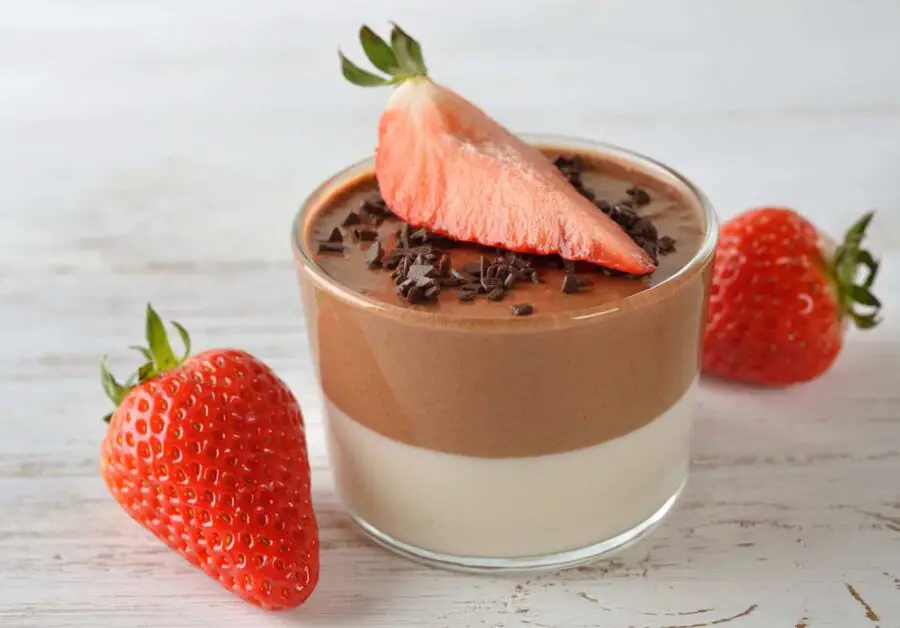If you’ve never tried authentic Bavarois (Bavarian cream), you are in for a real treat!
For most people, especially residents of the United States, what’s normally considered Bavarian cream is nothing like the original dessert.
Although the cream used to fill doughnuts or in between layers of cake is often referred to as Bavarian cream, it’s not traditional Bavarois. That’s considered confectioner’s custard and is also referred to as pastry cream or Crème pâtissière.
Bavarois is completely different.
Close your eyes and imagine taking a bite of something with the richness of buttercream and the structure of a custard and you have Bavarois.
Traditional Bavarois (Creme Bavarois or Bavarian Cream) is not a filling for pastry or frosting between cake layers but is a standalone dessert, similar in taste and texture to custard but with minor differences in ingredients, most notably the use of gelatin (as a thickening agent in a Crème Anglaise base) and whipped cream which adds lightness to its mouthfeel.
So, if we’ve piqued your interest so far, please continue on this journey of delicious dessert delights as we learn all about the wonder that is Bavarois.
Where Did Bavarois Come From?
The two main theories hold that Bavarois’ creation is attributed to Germany and/or France.
The German version is linked to a dynasty that ruled Germany for more than seven centuries. Known as the House of Wittelsbach, not only did the empire include Germany, which was then called Bavaria, but it also extended to neighboring countries like Holland, Hungary, Sweden and as far away as Greece!
With this vast wealth and power, extravagance was the norm, and this reached its peak during the 18th century when French chefs were regularly employed by the House of Wittelsbach. It’s thought that during this period, early prototypes of Bavarois first appeared, although there’s never been any substantial evidence.
In contrast to the German claim, perhaps the one that’s more widely recognized (and accepted) as the fact is that Bavarois was the creation of the legendary French chef, Marie-Antoine Carême during the 19th century – more on another contribution of his involving Bavarois a bit later in the article.
In either case, the popularity of Bavarois continued to grow and eventually found its way across the Atlantic to America. The earliest known mentions of it occurred in the Boston Cooking School Cookbook, published in 1896 by Fannie Farmer.
| Origin | Theory | Evidence |
|---|---|---|
| Germany | Creation attributed to the House of Wittelsbach during the 18th century | No substantial evidence |
| France | Creation attributed to Marie-Antoine Carême during the 19th century | Widely recognized and accepted as fact |
What Does Bavarois Mean?
Bavarois roughly translates to mean “Bavarian”. In the context of the dessert, it is thought by many to be an homage delightful treat’s home country of Bavaria, which today is Germany.
What Type of Dessert Is a Bavarois?
Bavarois can be thought of as a cross between pudding and custard-style dessert that is usually made from milk, eggs, gelatin, sugar and whipped cream.
When the milk, eggs, gelatin, and sugar are heated and combined, they create Crème Anglaise.
Once the mixture has cooled, the true magic occurs when whipped cream is folded in to add a satisfying thick, yet creamy texture.
The completed mixture is chilled in molds and when ready, it is removed from the mold and served.
How Is Bavarois Served?
Throughout the centuries, there have been many creative ways to serve Baravois, but perhaps the best known of them all is a variation of the Charlotte cake (or Ice Box cake) which is known as a Charlotte Russe.
Served cold, a Charlotte Russe is made by setting Bavarois in a mold that is lined with a type of English sponge cake, known as ladyfingers. Interestingly, the Bavarois variation of the Charlotte cake came about quite by accident.
The original Charlotte cake was named after the wife of England’s King George III, Queen Charlotte of Mecklenburg-Strelitz. The traditional Charlotte cake used bread dipped in butter as the base and cooked. Served warm or cold, they often featured seasonal fruits like apples, berries or pears.
Earlier you’ll recall we’d mentioned the famous French chef, Marie-Antoine Carême, as being thought of as the creator of Bavarois. What’s interesting is that he apparently used it in the creation of what’s today thought of as the Charlotte Russe.
As the story goes, when preparing his famed Bavarois for King Louis XVIII, he’d run short of gelatin needed to help the dessert set properly. In its place, he substituted ladyfingers, which not only rescued his presentation but became an instant favorite and remains so to this day.
| Serving Style | Description | Origin |
|---|---|---|
| Charlotte Russe | Served cold, made by setting Bavarois in a mold lined with ladyfingers. | Variation of the traditional Charlotte cake, which came about by accident. |
| Traditional Charlotte Cake | Served warm or cold, made with bread dipped in butter and cooked, often featuring seasonal fruits like apples, berries or pears. | Named after Queen Charlotte of Mecklenburg-Strelitz, wife of England’s King George III |

I’m Griffin and I make my living as a freelance writer and wannabe sci fi author. Besides my obsession with words, I have a few others which may or may not include craft beer, backcountry hikes and spending time with loved ones – preferably in that order. Thanks for checking out my work and I hope you enjoy it!

